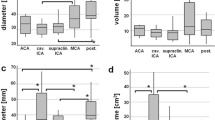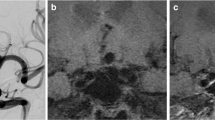Abstract
Endovascular treatment and prognosis of intracranial aneurysms are based on size and volume, which demand more accurate neuroimaging techniques. Aneurysm volume calculation is important to choose endovascular treatment modalities and packing density calculation. Of all these methods, it remains unknown which one is the most accurate to calculate aneurysm volume. The objective of this study is to compare the accuracy of three angiography-based versus three tomographic-based methods which calculate aneurysm volume. A retrospective study which included patients with ruptured and unruptured cerebral aneurysms diagnosed by angiogram and computed tomography angiography (CTA) was done. The accuracy of each method was assessed with an ellipsoid glass model of known volume, which helped us to adjust variation in volumetric measurements done with AngioSuite© and AngioCalc© softwares (based on angiographic and tomographic images), 3D–rotational angiography and 3D–CTA (tridimensional computed tomography angiography), based on measurements of diameters such as maximal width and maximal height. Descriptive statistics, ANOVA for repetitive samples and t test were used. We included 89 patients (126 saccular intracraneal aneurysms). AngioSuite© software (angiography-based) showed more accuracy compared to other methods in our control model. The geometric system (AngioCalc) based on CTA images was statistically different from all other methods studied. AngioCalc (CTA-based) demonstrated a significant difference compared with other methods hence, it may overestimate volume measurements. AngioSuite© software measurements (angiography-based) may be the most accurate method to calculate aneurysm volume.




Similar content being viewed by others
References
Fox AJ, Millar J, Raymond J, Pryor JC, Roy D, Tomlinson GA, McKay JP, Molyneux AJ (2009) Dangerous advances in measurements from digital subtraction angiography: when is a millimeter not a millimeter? AJNR Am J Neuroradiol 30(3):459–461. https://doi.org/10.3174/ajnr.A1381
Ruedinger KL, Rutkowski DR, Schafer S, Roldan-Alzate A, Oberstar EL, Strother C (2017) Impact of image reconstruction parameters when using 3D DSA reconstructions to measure intracranial aneurysms. J Neurointerventional Surg:neurintsurg-2017-013080. https://doi.org/10.1136/neurintsurg-2017-013080
Slob MJ, Sluzewski M, van Rooij WJ (2005) The relation between packing and reopening in coiled intracranial aneurysms: a prospective study. Neuroradiology 47(12):942–945. https://doi.org/10.1007/s00234-005-1446-9
Tamatani S, Ito Y, Abe H, Koike T, Takeuchi S, Tanaka R (2002) Evaluation of the stability of aneurysms after embolization using detachable coils: correlation between stability of aneurysms and embolized volume of aneurysms. AJNR Am J Neuroradiol 23(5):762–767
Slob MJ, van Rooij WJ, Sluzewski M (2005) Coil thickness and packing of cerebral aneurysms: a comparative study of two types of coils. AJNR Am J Neuroradiol 26(4):901–903
Yang P, Schafer S, Royalty K, Ahmed A, Niemann D, Strother C (2016) Measurement in the angiography suite: evaluation of vessel sizing techniques. J Neurointerventional Surg 8(9):965–968. https://doi.org/10.1136/neurintsurg-2015-011920
Sluzewski M, van Rooij WJ, Slob MJ, Bescos JO, Slump CH, Wijnalda D (2004) Relation between aneurysm volume, packing, and compaction in 145 cerebral aneurysms treated with coils. Radiology 231(3):653–658. https://doi.org/10.1148/radiol.2313030460
Woodward K, Forsberg DA (2013) AngioSuite: an accurate method to calculate aneurysm volumes and packing densities. Journal of neurointerventional surgery 5(Suppl 3):iii28–iii32
Chan SH, Wong KS, Woo YM, Chan KY, Leung KM (2014) Volume measurement of the intracranial aneurysm: a discussion and comparison of the alternatives to manual segmentation. J Cerebrovasc Endovasc Neurosurg 16(4):358–363. https://doi.org/10.7461/jcen.2014.16.4.358
Piotin M, Daghman B, Mounayer C, Spelle L, Moret J (2006) Ellipsoid approximation versus 3D rotational angiography in the volumetric assessment of intracranial aneurysms. AJNR Am J Neuroradiol 27(4):839–842
Erhardt S, Marbacher S, Neuschmelting V, Coluccia D, Remonda L, Fandino J (2014) Comparison between routine cylindrical cerebral aneurysm volume approximation and three-dimensional volume measurements in experimental aneurysms. Neurol Res 36(8):739–745. https://doi.org/10.1179/1743132813Y.0000000316
Piotin M, Gailloud P, Bidaut L, Mandai S, Muster M, Moret J, Rüfenacht DA (2003) CT angiography, MR angiography and rotational digital subtraction angiography for volumetric assessment of intracranial aneurysms. An experimental study. Neuroradiology 45(6):404–409. https://doi.org/10.1007/s00234-002-0922-8
Hanley M, Zenzen WJ, Brown MD, Gaughen JR, Evans AJ (2008) Comparing the accuracy of digital subtraction angiography, CT angiography and MR angiography at estimating the volume of cerebral aneurysms. Interv Neuroradiol: J Peritherapeutic Neuroradiol, Surg Proced Relat Neurosci 14(2):173–177. https://doi.org/10.1177/159101990801400208
Chandran A, Radon M, Biswas S, Das K, Puthuran M, Nahser H (2016) Novel use of 4D-CTA in imaging of intranidal aneurysms in an acutely ruptured arteriovenous malformation: is this the way forward? J Neurointerventional Surg 8(9):e36. https://doi.org/10.1136/neurintsurg-2015-011784.rep
Lang S, Golitz P, Struffert T, Rosch J, Rossler K, Kowarschik M et al (2017) 4D DSA for dynamic visualization of cerebral vasculature: a single-center experience in 26 cases. AJNR Am J Neuroradiol 38(6):1169–1176. https://doi.org/10.3174/ajnr.A5161
Author information
Authors and Affiliations
Contributions
VH Escobar-de la Garma: Conception, design, analysis and interpretation of data of the work
VH Escobar-de la Garma, F Padilla-Vázquez, and A Cerón-Morales: Acquisition of data
D San-Juan: Drafting the work, revision, and interpretation of data
M Zenteno: Final approval of the version to be published
Corresponding author
Ethics declarations
Conflict of interest
The authors declare that they have no conflict of interest.
Ethical standards and patient consent
We declare that this manuscript does not contain clinical studies or patient data.
Rights and permissions
About this article
Cite this article
Escobar-de la Garma, V.H., Zenteno, M., Padilla-Vázquez, F. et al. Comparative analysis of aneurysm volume by different methods based on angiography and computed tomography angiography. Neurosurg Rev 41, 1013–1019 (2018). https://doi.org/10.1007/s10143-018-0943-3
Received:
Revised:
Accepted:
Published:
Issue Date:
DOI: https://doi.org/10.1007/s10143-018-0943-3




